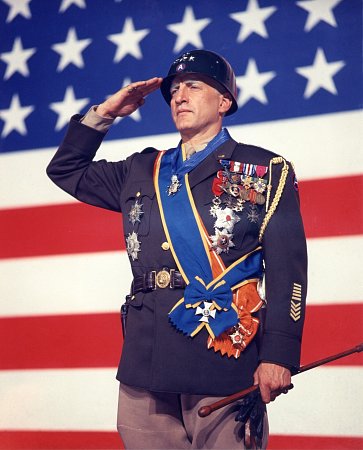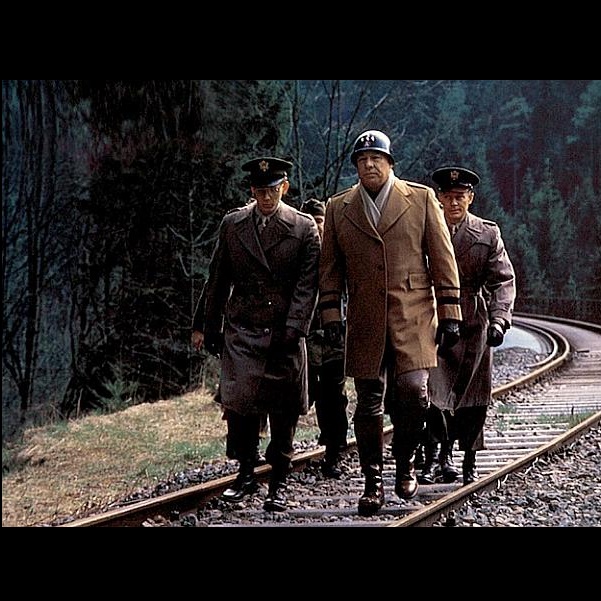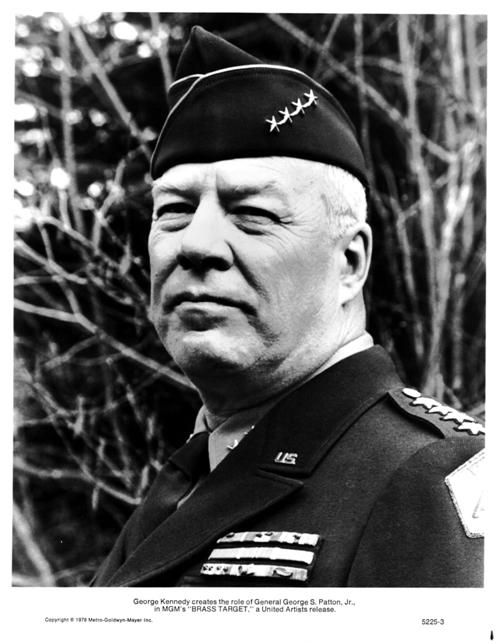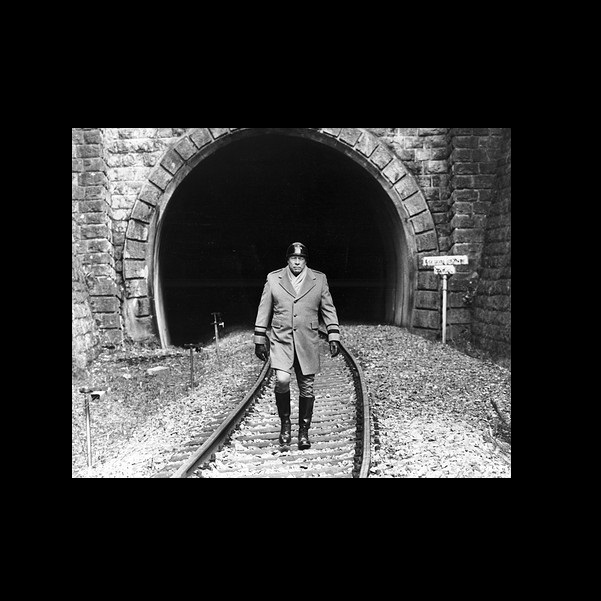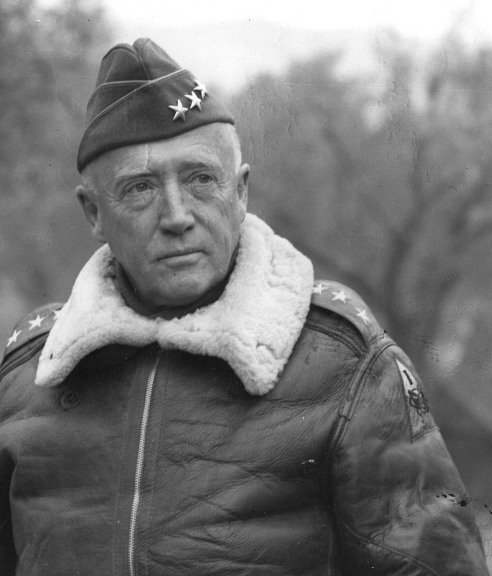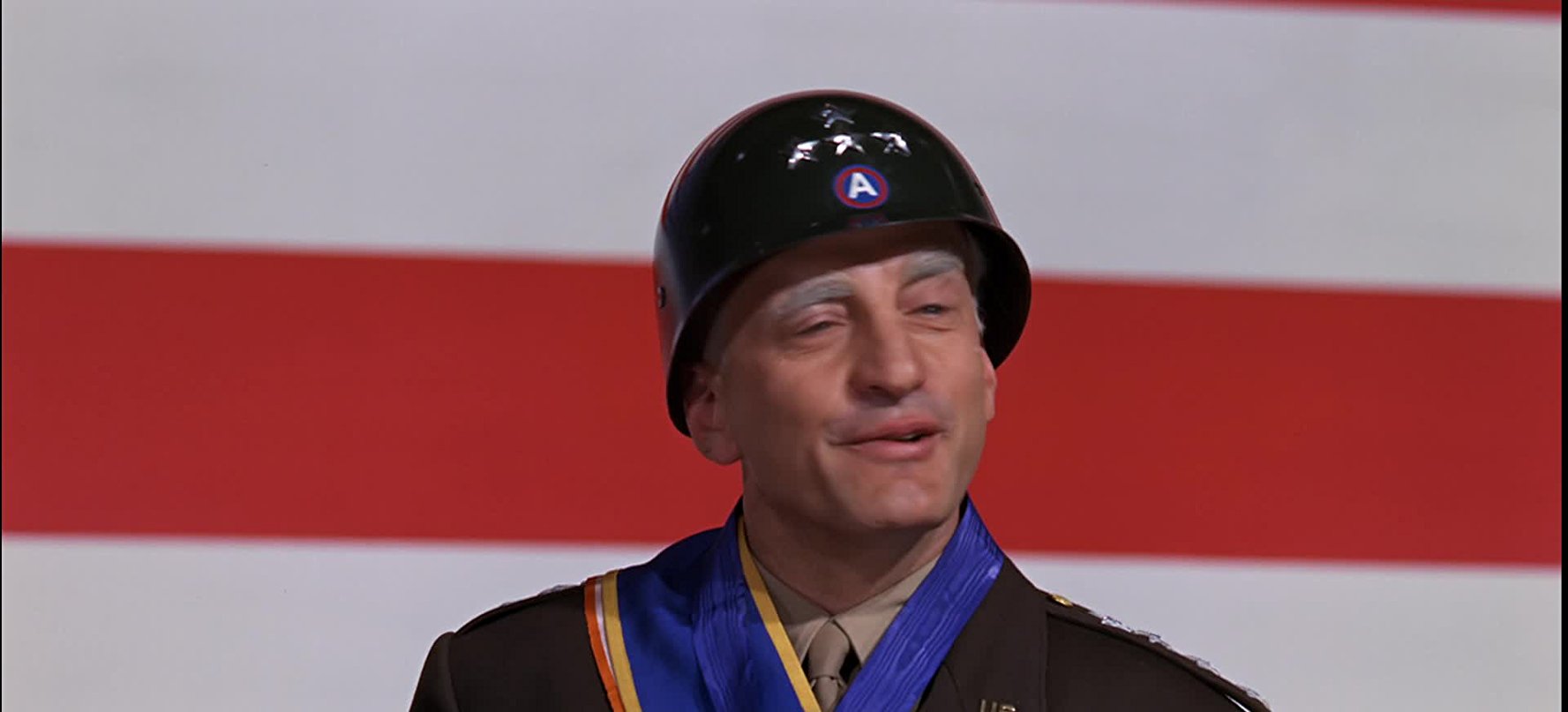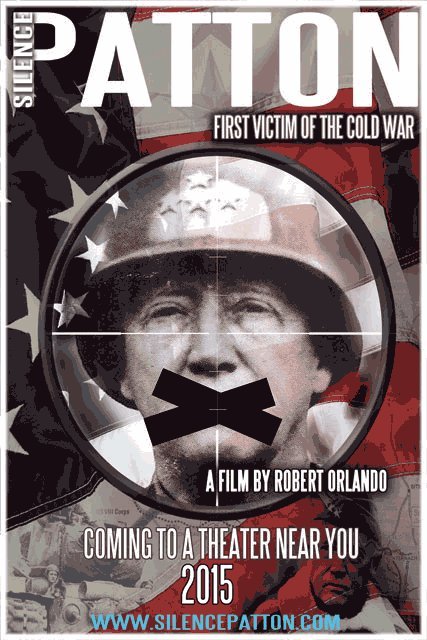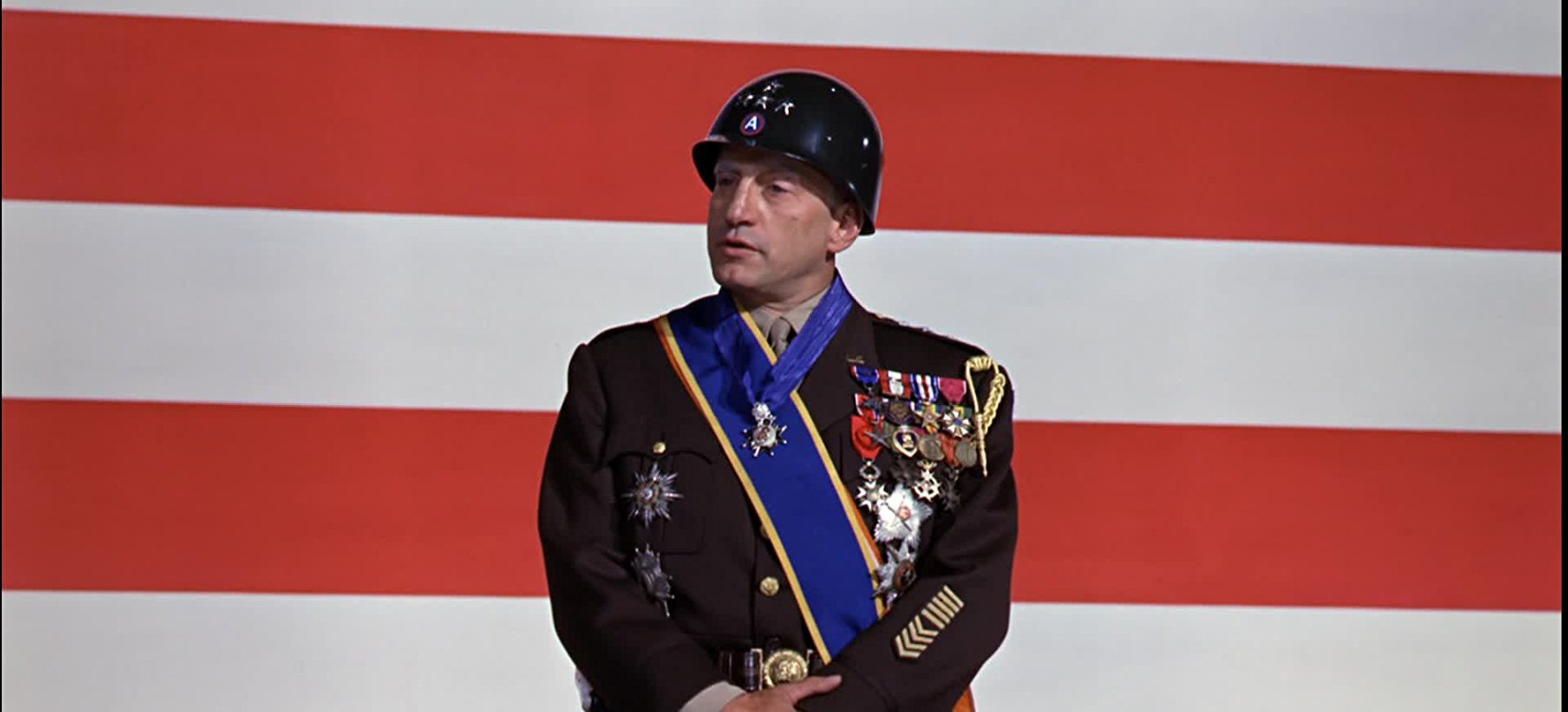The name of George S. Patton is practically synonymous with the history of US Army armored warfare in the first half of the 20th Century.George Smith Patton Jr. was born on November 11, 1885 in San Gabriel, California. (He was actually George Smith Patton III but, as he was born long after the death of his grandfather, almost always referred to himself as George S. Patton Jr.) His grandfather, the first George S. Patton, was a colonel in the Confederate Army during the American Civil War, as was his great-uncle, Waller Tazewell Patton. The two Patton brothers were killed in action, Tazewell during Pickett's Charge at the Battle of Gettysburg in 1863, and George at the Battle of Opequon, Virginia in 1864. The Patton brothers were the Great-grandsons of General Hugh Mercer, a Revolutionary War hero who was killed at the Battle of Princeton in 1777.Constantly reminded of, and inspired by his military heritage as he grew up, Patton aspired to a military career from early childhood. He attended the Virginia Military Institute (his father's and grandfather's alma mater) for one year before securing an appointment to the US Military Academy at West Point in 1904. Difficulties in Math caused him to be left back at the end of his first ( Plebe ) year, and he graduated with the Class of 1909.Patton was commissioned a second lieutenant in the Cavalry upon graduation. Highlights of his early career included selection to attend the cavalry school of the French Army; participation in the military pentathlon (running, swimming, fencing, pistol marksmanship and steeplechase) and placing fifth at the 1912 Olympics in Stockholm, Sweden; and designing a new saber for the US Cavalry (which was known ad the Patton Saber). He married a childhood sweetheart, Beatrice Ayer, daughter of the founder of a Boston pharmaceutical company. They had two daughters, Bea and Ruth, and a son, George.During the 1916 punitive expedition on the US border with Mexico in pursuit of Pancho Villa, Patton was assigned to the staff of then-Brigadier General John J. Pershing. He got his first taste of combat leading a small raiding party mounted on automobiles, on a house occupied by members of Villa's guerrilla organization. In that action, which is the earliest recorded military motorized assault in US Army history, Patton killed two of Villa's officers using what would become known as his trademark sidearm: a nickel plated, ivory-handled Colt .45 Model 1873 revolver.At the entry of the United States into the First World War in 1917, Pershing, newly appointed as a full general and commander of the American Expeditionary Force, retained Patton on his staff. As the tank rose to prominence as a weapon at the front in France, Patton quickly recognized it as the modern replacement of the horse in the cavalry role, and eagerly accepted his assignment from Pershing as head of the US Tank Corps in France; he rose rapidly in rank to lieutenant colonel. He organized and trained his force, designated the 304th Tank Brigade, and led it in its first battles in the Meuse-Argonne Offensive. He was shot through the thigh and buttocks at the Battle of St. Mihiel in September 1918, and was recuperating in the hospital when the war ended on his 33rd birthday.He had been promoted to full colonel while recuperating, but like most career officers, reverted to his lower permanent rank (captain) as the Army demobilized. As the Tank Corps was disbanded and absorbed into the Infantry, he returned to the horse cavalry. His duties between the two World Wars included assignment to the staff of Army Chief of Staff General Douglas MacArthur (during which he and his friend and fellow major Dwight D. Eisenhower participated in the routing of the protesting Bonus Army in Washington DC in 1932), and command of the 3rd Cavalry Regiment, rising back to the rank of full colonel.At the time of the United States' entry into World War II in 1941, Patton was a major general (2 stars) in command of the 2nd Armored Division, the old Tank Corps having been reestablished as the Armored Force and with himself having commanded most of the few US tank actions in the last war. He was selected to command the Western Task Force during the invasion of North Africa (Operation Torch) in November 1942, under the overall command of his old friend, now-General Dwight Eisenhower. During the North African campaign, he was promoted to lieutenant general (three stars) and placed in command of the II Corps in March 1943 following their disastrous defeat at the hands of German Field Marshal Erwin Rommel's Afrika Korps at Kasserine Pass, Tunisia. His reputation as a tough disciplinarian proved itself as he rebuilt the II Corps and led it in successive victories against the Germans across Tunisia.Attention was then shifted to the upcoming invasion of island of Sicily (Operation Husky) in July 1943, for which Patton was moved up the chain of command to command of the US 7th Army, passing command of II Corps to his deputy, Lieutenant General Omar N. Bradley. Given a supporting role in the Sicily campaign (with the main effort assigned to the British 8th Army under General Bernard L. Montgomery), Patton quickly seized his primary objective of Palermo in the northwest corner of the island. He then began a race with Montgomery for the final objective of Messina, the seaport city in the northeast corner, closest to the Italian mainland. Patton drove the 7th Army hard and succeeded in beating the British 8th Army and Montgomery to Messina.However, his victory against the German enemy and triumph over his British rival was marred by an incident during a visit by Patton to a field hospital in which he encountered a soldier with malaria, but who had been misdiagnosed as having combat fatigue. Patton accused the soldier of malingering and cowardice and slapped him in the face. Under outcry from the public at home once news of the slapping incident broke out, Patton publicly apologized to the soldier, but was relieved of command of the 7th Army.For nearly a year, Patton was on probation and without command, but General Eisenhower, recognizing that Patton was the Allied commander most feared by the Germans, used his reputation as part of a deception plan in the upcoming invasion of France. While plans went forth for the actual invasion from England across the western end of the English Channel at Normandy (Operation Overlord), Eisenhower summoned Patton to England and had him establish a headquarters for a phantom Army Group, with dummy troop concentrations and weapons buildups and fake radio traffic at the eastern end of the Channel, around its narrowest point across from Calais. An incident at Knutsford, England, in which Patton made a speech that was perceived to be a slight against the Soviet allies (controversy still remains as to whether or not he actually omitted them in remarks about rule of the postwar world) threatened to further sink his career and end even his command of the phantom force.The deception succeeded, with the Germans convinced that the landings in Normandy on June 6, 1944 were only a diversion. The Germans were still keeping a large portion of their own armored forces in the Calais area, awaiting the real invasion by Patton's phantom Army Group, when his new real command, the heavily armored US 3rd Army, arrived at the established beachheads in Normandy in August 1944.Patton's 3rd Army then spearheaded the Allied breakout from Normandy (Operation Cobra), fanning out in five different axes of advance to the East, South and West. Patton used the principles of rapid penentration and exploitation by tank-heavy forces supported by close air support, essentially outdoing the Germans at their own concept of Blitzkrieg.As more Allied forces arrived in France across a wide front, the 3rd Army, as part of the 12th Army Group under Patton's former subordinate Omar Bradley, advanced in the late Summer and Fall of 1944 through the Lorraine region and across the border into Germany itself. Often, Patton and his army were forced to slow down, not due to resistance from the Germans, but because they had outrun their own supply lines, or in the case of Operation Market-Garden (the trouble-plagued invasion of Holland under the command of Montgomery in September 1944) because supplies had been reduced and diverted.Patton had established a foothold across the German border, and was about to launch an offensive eastward into the industrial regions of the Saar Valley in Germany in December 1944 when news arrived that the Germans had launched a surprise counterattack (soon to be known as the Battle of the Bulge) against the US First Army in Luxembourg and Belgium immediately to their north. The Germans had taken advantage of one of the worst blizzards in European history which grounded the Allied air forces. As Eisenhower summoned his Army and Army Group commanders to his headquarters to counter the new threat, Patton directed his staff to make contingency plans to turn the entire 450,000 man 3rd Army 90 degrees left to attack the flank of the German Army. The briefing at Eisenhower's headquarters revealed that while the Germans had driven a salient over 60 miles deep into Belgium, a force consisting of the 101st Airborne Division and elements of the 10th Armored Division had held on to the town of Bastogne in the center of the salient. Although surrounded, Bastogne was a critical road junction, and by holding it the 101st Airborne and 10th Armored had slowed down the German offensive. The key to stopping the Germans was breaking through and relieving those units before they ran out of supplies and were overrun. With his utmost self-assurance, Patton announced that he could begin his attack in three days, and then did so by simply phoning his headquarters with the appropriate code word. Over the next nine days, the entire 3rd Army shifted its axis of attack 90 degrees and marched approximately 100 miles while on the attack in a blizzard. In dramatic fashion, Patton directed his chief of chaplains, Colonel (Monsignor) James H. O'Neill, to write a prayer, which asked for fair weather for battle... that we may... crush the wickedness and oppression of our enemies, and establish Thy Justice among men and nations. The prayer was printed and distributed to all the troops, and the weather unexpectedly cleared up, allowing the resumption of close air support and the air-dropped resupply of the besieged units at Bastogne. The German counteroffensive had begun on December 16, and 3rd Army broke through to Bastogne on the day after Christmas.After the German salient or bulge was flattened at the end of January 1945, the Allies resumed their offensive into Germany itself, with the 3rd Army crossing the Rhine River in late March. The one major defeat suffered by Patton's forces during this period was when a battalion-sized task force was sent deep behind German lines to liberate a Prisoner of War camp at Hammelburg, and was instead cut off with most members captured themselves. The controversy of this failure worsened when it was revealed that Patton had evidently ordered the raid after learning that his son-in-law, a lieutenant colonel captured in North Africa, was among the prisoners at the camp.Although forbidden by agreement with the Soviets from going into the German capital of Berlin, the 3rd Army reached as far east as Czechoslovakia and Austria before the German surrender in May 1945. Patton was promoted to full (4-star) general two weeks before the surrender.Patton had hoped for a transfer to the Pacific Theater of Operations for the planned invasion of Japan (an issue that became moot with the Japanese surrender in August); instead, in his position as Commander of 3rd Army, he became Military Governor of Bavaria, a duty he neither wanted nor felt himself suited for. More controversy plagued him when he did not remove all former Nazi Party members from the civilian government positions as directed, arguing that he needed people who could keep the local governments functioning and that most Nazi Party members were members in the same way that Americans were Republicans or Democrats. General Eisenhower relieved him of command of 3rd Army in October 1945 and placed him in command of the 15th Army, a headquarters-only unit tasked with compiling the history of the war in Europe.Patton made arrangements to return to the US, with the intention of retiring if he could not obtain a satisfactory new assignment. On December 9, 1945, the day before he was scheduled to leave, he was on his way to a pheasant hunt with his former chief of staff, Brigadier General Hobart Gay, when his staff car collided with an Army communications truck near Neckarstadt, Germany. Gay and the driver were uninjured, but Patton's neck was broken and he was left almost totally paralyzed. He died of his injuries in the Army hospital in Heidelberg, Germany on December 21, 1945 with his wife Beatrice at his bedside, and was interred in the US Military Cemetery in Hamm, Luxembourg. In accordance with his own wishes, his grave was initially among the rows with those of his troops, but the volume of visitors trampling on the grass on neighboring graves necessitated his reburial at the front of the cemetery, positioned much like a commander with his troops passing in review.The succession of US Army main battle tanks that began production at the end of World War II, and continued to undergo improvements and remain in service until the mid-1990s (the M-46, M-47, M-48 and M-60 series) were all collectively named the Patton series in his honor.His son, George S. Patton IV (1923-2004), who was in his last year at West Point at the time of his father's death, went on to become a respected and decorated armor/cavalry commander during the Korean and Vietnam Wars, and a general officer in his own right.The seven-Oscar 1970 film Patton, with George C. Scott in the title role, is considered a landmark in film biography. The real-life General Patton's voice, however, was rather high-pitched and crackly, more resembling that of business magnate H. Ross Perot and sounding nothing like Scott's gravelly baritone. Scott's portayal has become so iconic that most people are shocked with disbelief upon seeing sound films or listening to voice recordings of the real Patton.Written by:Lyle F. PadillaMajor, Armor, US Army Reserve (Retired)
[email protected] Show less «

